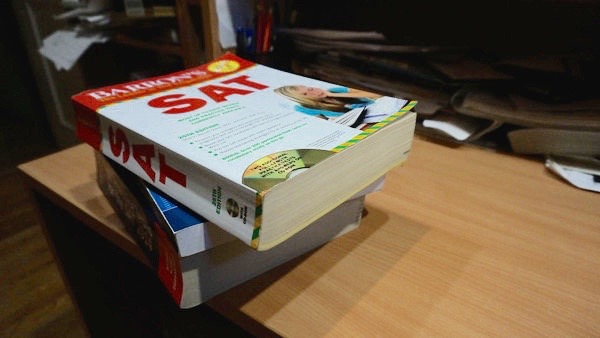
Credit: Angela Park
Olivia Waldron, Lucy Hughes, and Naomi Lathan share their three different approaches to studying for the SAT.
3 ways to study for the SAT
With college on the horizon, rising juniors may be nervous about beginning to prepare for the SAT. Class of 2018’s Naomi Lathan, Olivia Waldron, and Lucy Hughes are here to help you decide how to study by explaining their different approaches to the test. Happy studying!
Studying by yourself
This method of studying is only for students who are disciplined in their study habits and confident in their ability to learn independently.
- It all starts with picking a book. Research how much detail each one goes into, and choose the level of thoroughness that is right for you.
- Most books have multiple practice tests. Take one of the tests in your book as a diagnostic to give yourself a starting point and a general idea of the parts that you need to work on.
- The next step–the most important step–is to make a study plan. Look at how much time you have until the test and make a general outline of where you want to be at the end of each week. Make sure you finish going through all of the material a week or two before the test, so you have time to just practice answering questions. Do your best to follow your study plan, but don’t stress about meeting your deadlines.
- Work through all of the material once, and mark the sections that you are least comfortable with. Later, when it gets closer to the test, you know that you should do the drills and practice problems for this section.
- A week or two before the test, take another full practice test. This will not only give you an idea of what it’s like to take the test but will also most likely boost your confidence when you compare your diagnostic score to your later score.
Wind down your studying the week before the test. Spend your time close to the test getting enough sleep and de-stressing.
Studying with a tutor
I would recommend studying for the SAT with a tutor if you tend to zone out a lot and have a hard time paying attention in class. With a one-on-one environment, it is impossible to get distracted and tune out what the tutor is saying. You are also more motivated to do your homework because you are the only one there and there is no way of hiding it.
There are many companies that can be used including Kaplan and Weston Tutor Collaborative in the Weston Town Center. You can request a tutor that comes to your house or one that meets with you at their office, whichever one works for your learning style. I personally used a tutor that came to my house, and I was assigned weekly homework that she would check every time she came. We would go over rules and topics together, and then we would do a few practice problems together to make sure I understood enough to practice on my own.
Studying with a class
Taking an online class is a great alternative to taking a physical SAT/ACT class. This process is great for busy people who are always on the move and don’t have time to go to a classroom. I took the course over the summer while I was constantly traveling around the country, so the online course gave me leeway to take the course wherever I wanted.
One night each week should be reserved for the online class, typically a three-hour session each week. My class was every Sunday night, but this can vary depending on what class you sign up for. Find a quiet space and log onto the website. The class I took was through the company Revolution Prep, which specializes in online tutoring for various subjects and standardized testing. When taking a course, the teacher will start the class at a designated time by signing into the video call, enabling all students to see and hear the teacher, as well as each other. The course I took had about seven other students from around the country, but there are many different class options like private, semi-private or group tutoring. The video call is high quality and the teacher has a special microphone in place which makes them easy to understand. In lessons, the teacher will give and review practice exams and problems, answer questions people have, and teach lessons about timing. Homework is assigned each week; in my class, it was one practice test and a few extra problems that would be reviewed in the next class. If there were any questions, the tutor was always available through email. The drawbacks I struggled with were that when multiple people started talking at a time, it was chaotic to try figuring out who would be able to speak and be heard in front of the class. However, with the help of the teacher, we were able to solve this problem by pressing a button when we had a question or chose to talk. Additionally, if someone does not want to speak up, there is a chat next to the screen which is viewable by all participants, where questions can be asked and answered.
The online course was perfect for me because it allowed flexibility in location. The course helped me a lot in the actual SAT and without it, I would not have gotten the score I ended up with. I strongly recommend this process for students who are interested.